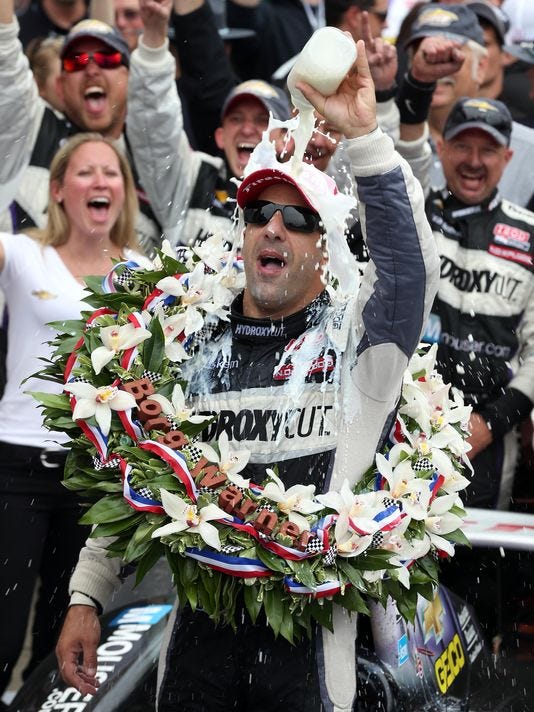More than
any other race, the Indianapolis 500 can make or break an entire season, and in
some cases – Buddy Lazier and Buddy Rice, for example- entire careers. Sunday’s
race proved no exception, as the month of May saw its winners and losers at
Indianapolis.
Winner:
Tony Kanaan
Of course,
the obvious winner was the, uh, race winner, Tony Kanaan. A sentimental
favorite of both the IndyCar community and the fans at Indianapolis, Kanaan
broke through his hard-luck past and finally celebrated with his long-awaited
drink of milk. Since his rookie year in 2002, Kanaan had led races – at least
one lap in each of his first seven starts - and even qualified for the pole in
2005. Frustrated by a second and third place finishes, and finishes under the
yellow preventing him from any last lap dramatics, karma came full circle and
provided Kanaan a win when the yellow caution flag flew moments after Kanaan
burst into the lead on a restart on lap 197. Always a master at starts and
restarts, it’s fitting Kanaan’s victory came as a result of one of his primary
strengths.
Winner:
Andretti Autosport
So, neither
Marco Andretti or any of his four teammates at Andretti Autosport ended up in
Victory Circle, the entire organization flexed its muscles as the team to beat
for the remainder of this year. Recall, it was just a couple of years ago when
Andretti Autosport had difficulty even qualifying for Indy, with Danica Patrick
barely squeaking into the field and Ryan Hunter-Reay missing out entirely (he
raced only after owner Michael Andretti bought the qualified car of Bruno
Junqueira and put Hunter-Reay into it). This year, Andretti drivers were fast
off the truck, and showed their muscle in the race, with Carlos Munoz,
Hunter-Reay and Andretti taking 2nd, 3rd & 4th.
Loser:
Honda
First,
traditional series stalwart Honda was locked out on pole day, as the fast nine
qualifiers shooting out for the pole position all boasted Chevy power plants.
Then, race day provided insult to injury, with various Chevy drivers
continually shuffling the lead, allowing Honda-powered drivers a spot at the
front only when green flag pit stops temporarily shuffled the order. Honda
looked lost all month, and it appeared they lacked the needed power to overtake
down Indy’s long straights.
Winner:
Carlos Munoz
Sunday’s
Indy 500 was not only Munoz’ IndyCar debut, it was also the first race of any
kind where pit stops were necessary. All Munoz did was run up front all day,
battled for the lead and positioned himself for a last lap dash at victory. If
it wasn’t for the yellow flag ending the race toward the checkereds, he very
well might have found himself in Victory Circle.
Loser:
Target Chip Ganassi Racing
Target Chip
Ganassi struggled all month at Indy, with Scott Dixon and Dario Franchitti
qualifying mid-field and then seemingly anchored there throughout the race.
When defending champ Franchitti wrecked in Turn One with three laps to go, he
essentially ended the race and provided a fitting close to what proved to be a
frustrating and forgettable month for Ganassi.
Winner:
IndyCar
A record
number or leaders and a doubling – yes, doubling! – of the record number of
lead changes from just one year previous showed Indy has begun to regain its
lost mojo of the early 90’s heyday. True, the racing was more or less
single-file, but at least the point car changed often, as the leader had a “sitting
duck” aura about him. The race was
another step in the right direction, and it’s up to IndyCar to maintain the
momentum through what has in the past been the humdrum part of its season.
Go two-wide on Twitter @RayHartjen






